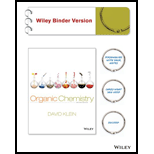
(a)
Interpretation:
The efficient synthetic route for the given target molecules and transformation should be identified.
The reagents used to accomplish the given efficient transformations should be determined.
Concept Introduction:
Halogenation: The addition of halogen atoms to a
Soda amide: The strong base of
Markovnikov’s Rule: The unsymmetrical alkene in a chemical compound reacts with hydrogen halide in a way, where halide ions attacks and bond to the more substitution position of carbon-carbon double bond.
Hydrogen reduction reaction: The alkenes or alkynes can be reduced to
Birch reduction: The conjugated alkynes and benzenes in the presence of sodium metal in liquid ammonia and alkyne produced a non-conjugated diene system. The alkyne involves sodium
Hydrogenation: The hydrogenation is a reduction reaction which results in an addition of hydrogen. Several organic compounds (alkenes, alkynes) is hydrogenated, it becomes more saturated.
Acid Catalyzed Hydration Reaction: The reaction involves breaking of phi bonds between carbon-carbon multiple bonds and addition of alcohol to more substituted position of carbon in the molecule.
(b)
Interpretation:
The efficient synthetic route for the given target molecules and transformation should be identified.
The reagents used to accomplish the given efficient transformations should be determined.
Concept Introduction:
Halogenation: The addition of halogen atoms to a
Soda amide: The strong base of
Markovnikov’s Rule: The unsymmetrical alkene in a chemical compound reacts with hydrogen halide in a way, where halide ions attacks and bond to the more substitution position of carbon-carbon double bond.
Hydrogen reduction reaction: The alkenes or alkynes can be reduced to alkanes with H2 in the presence of metal catalyst
Birch reduction: The conjugated alkynes and benzenes in the presence of sodium metal in liquid ammonia and alkyne produced a non-conjugated diene system. The alkyne involves sodium
Hydrogenation: The hydrogenation is a reduction reaction which results in an addition of hydrogen. Several organic compounds (alkenes, alkynes) is hydrogenated, it becomes more saturated.
Acid Catalyzed Hydration Reaction: The reaction involves breaking of phi bonds between carbon-carbon multiple bonds and addition of alcohol to more substituted position of carbon in the molecule.
(c)
Interpretation:
The efficient synthetic route for the given target molecules and transformation should be identified.
The reagents used to accomplish the given efficient transformations should be determined.
Concept Introduction:
Halogenation: The addition of halogen atoms to a
Soda amide: The strong base of
Markovnikov’s Rule: The unsymmetrical alkene in a chemical compound reacts with hydrogen halide in a way, where halide ions attacks and bond to the more substitution position of carbon-carbon double bond.
Hydrogen reduction reaction: The alkenes or alkynes can be reduced to alkanes with H2 in the presence of metal catalyst
Birch reduction: The conjugated alkynes and benzenes in the presence of sodium metal in liquid ammonia and alkyne produced a non-conjugated diene system. The alkyne involves sodium
Hydrogenation: The hydrogenation is a reduction reaction which results in an addition of hydrogen. Several organic compounds (alkenes, alkynes) is hydrogenated, it becomes more saturated.
Acid Catalyzed Hydration Reaction: The reaction involves breaking of phi bonds between carbon-carbon multiple bonds and addition of alcohol to more substituted position of carbon in the molecule.
(d)
Interpretation:
The efficient synthetic route for the given target molecules and transformation should be identified.
The reagents used to accomplish the given efficient transformations should be determined.
Concept Introduction:
Halogenation: The addition of halogen atoms to a
Soda amide: The strong base of
Markovnikov’s Rule: The unsymmetrical alkene in a chemical compound reacts with hydrogen halide in a way, where halide ions attacks and bond to the more substitution position of carbon-carbon double bond.
Hydrogen reduction reaction: The alkenes or alkynes can be reduced to alkanes with H2 in the presence of metal catalyst
Birch reduction: The conjugated alkynes and benzenes in the presence of sodium metal in liquid ammonia and alkyne produced a non-conjugated diene system. The alkyne involves sodium
Hydrogenation: The hydrogenation is a reduction reaction which results in an addition of hydrogen. Several organic compounds (alkenes, alkynes) is hydrogenated, it becomes more saturated.
Acid Catalyzed Hydration Reaction: The reaction involves breaking of phi bonds between carbon-carbon multiple bonds and addition of alcohol to more substituted position of carbon in the molecule.
Want to see the full answer?
Check out a sample textbook solution
Chapter 10 Solutions
Organic Chemistry, Binder Ready Version
 ChemistryChemistryISBN:9781305957404Author:Steven S. Zumdahl, Susan A. Zumdahl, Donald J. DeCostePublisher:Cengage Learning
ChemistryChemistryISBN:9781305957404Author:Steven S. Zumdahl, Susan A. Zumdahl, Donald J. DeCostePublisher:Cengage Learning ChemistryChemistryISBN:9781259911156Author:Raymond Chang Dr., Jason Overby ProfessorPublisher:McGraw-Hill Education
ChemistryChemistryISBN:9781259911156Author:Raymond Chang Dr., Jason Overby ProfessorPublisher:McGraw-Hill Education Principles of Instrumental AnalysisChemistryISBN:9781305577213Author:Douglas A. Skoog, F. James Holler, Stanley R. CrouchPublisher:Cengage Learning
Principles of Instrumental AnalysisChemistryISBN:9781305577213Author:Douglas A. Skoog, F. James Holler, Stanley R. CrouchPublisher:Cengage Learning Organic ChemistryChemistryISBN:9780078021558Author:Janice Gorzynski Smith Dr.Publisher:McGraw-Hill Education
Organic ChemistryChemistryISBN:9780078021558Author:Janice Gorzynski Smith Dr.Publisher:McGraw-Hill Education Chemistry: Principles and ReactionsChemistryISBN:9781305079373Author:William L. Masterton, Cecile N. HurleyPublisher:Cengage Learning
Chemistry: Principles and ReactionsChemistryISBN:9781305079373Author:William L. Masterton, Cecile N. HurleyPublisher:Cengage Learning Elementary Principles of Chemical Processes, Bind...ChemistryISBN:9781118431221Author:Richard M. Felder, Ronald W. Rousseau, Lisa G. BullardPublisher:WILEY
Elementary Principles of Chemical Processes, Bind...ChemistryISBN:9781118431221Author:Richard M. Felder, Ronald W. Rousseau, Lisa G. BullardPublisher:WILEY





